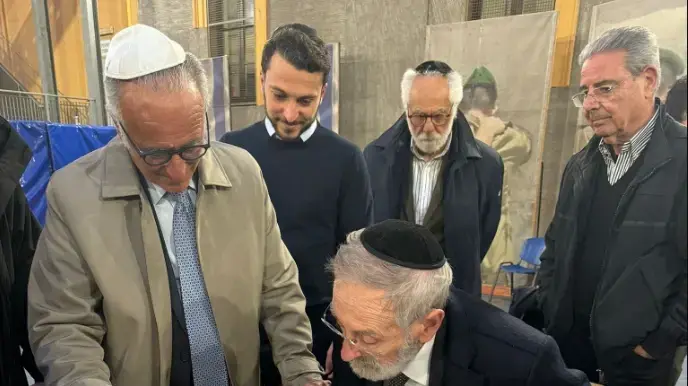Out of sight, out of mind
This is exactly what happened to the synagogue on Reichenbachstrasse.
The house of God is a real jewel that is now to be renovated.
It just so happens that nobody comes in here.
Because this Munich jewel is hidden behind dark doors: the synagogue on Reichenbachstrasse.
It was almost forgotten, but it is so valuable - a real treasure in the backyard.
90 years after its construction, it is now to be completely renovated.
“The synagogue is one of the most important sacred buildings in Munich and, with its new objectivity style, is a jewel in international architectural history,” says Rachel Salamander.
The bookseller and literary scholar wants to save this gem.
Since the synagogue was no longer needed in 2006, it is threatened with decay.
Salamander simply could not and would not accept that.
So in 2013 she founded the association “Synagoge Reichenbachstraße e.
V. ".
+
From the street, the building in the backyard cannot be seen.
© Marcus sleep
The renovation of the synagogue preserves the only preserved pre-war building of Munich Jewry for the Jewish community and gives the city of Munich and its citizens back a unique art monument, explains Salamander.
And the synagogue also has a special meaning for the 72-year-old herself, as it was her religious home for 40 years.
The aim is to restore the building based on the original building from 1931.
Eventful history of the Reichenbachstrasse synagogue
At that time it was planned by the architect Gustav Meyerstein. The construction of the synagogue on Reichenbachstrasse took only five months in 1931. It was precisely placed in a back courtyard between the Isar and Gärtnerplatz and inaugurated on September 5, 1931. Against the background of the burgeoning National Socialism, the synagogue was "reserved and simple", but with a striking color scheme. “It must have been a real frenzy of colors,” says Salamander.
Before the construction began, two Jewish prayer associations had come together, which had been founded mainly by immigrants from Eastern Europe.
The synagogue was devastated and set on fire during the Reichspogromnacht in November 1938.
The fire brigade put out the flames as they threatened to jump over to the outbuildings.
During the Nazi regime, the synagogue was used for other purposes.
In 1943 the entire building was sold.
A car workshop was set up there, and other rooms were used as warehouses.
Rachel Salamander is committed to the redevelopment
The “Reichenbachschul”, as the synagogue is also called by the Jews, survived the Second World War and was re-inaugurated in 1947 - as the main synagogue of the Israelite religious community in Munich and Upper Bavaria, with 330 male and 220 female beds on the gallery.
It remained the main synagogue until it was replaced by Ohel Jakob on Jakobsplatz in 2006 - and almost fell into oblivion.
Until Salamander passed there by chance in 2011 and it "stung her" when she saw the dilapidated church.
+
Rachel Salamander is committed to the renovation of the synagogue.
© Marcus sleep
So she acted. “Our generation must not only complain about the destruction of Judaism by the Nazis, but must also take responsibility itself,” she says. A lot of research followed in order to find out as much as possible about the synagogue and, with the renovation, to get as close as possible to the original building from 1931. "By removing layers of paint, we were able to see the original color, as it was described at the time," reports Ron C. Jakubowicz. "That was this light blue and the yellowish glass on the ceilings resulted in this turquoise tone."
The renovation is expected to cost around ten million euros and is financed by the city, the Free State and the federal government in equal thirds.
When it will be finished is not yet certain.
But one thing is clear: the building should be fully ritual and accessible to the public.
For example, lessons for schools and cultural events are also planned.
+
This is what the synagogue should look like after the renovation.
© HILMER & SATTLER and ALBRECHT Gesellschaft von Architekten mbH, SCHINDHELM Moser Architekten GbR
Interested
have the opportunity to visit the construction site for a few weeks from Wednesday.
Always on Wednesdays (5 p.m.) and Sundays (11 a.m.).
In the synagogue, audio and film reports provide information about the history of the building and the district, combined with personal memories from contemporary witnesses.
Admission is free, prior registration is required.
Information is available on the net at www-juedisches-museum-muenchen.de.












/cloudfront-eu-central-1.images.arcpublishing.com/prisa/KMEYMJKESBAZBE4MRBAM4TGHIQ.jpg)

